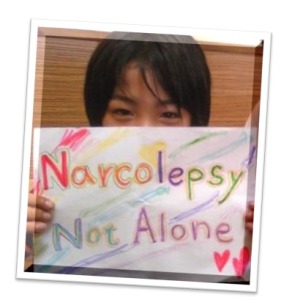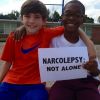Narcolepsy FactsInfographicFAQs
Definition:
Narcolepsy is a neurological disorder in which the brain loses the ability to maintain the proper sleep/wake cycle. Affects 1 in 2,000 people, including 200,000 Americans, 3 million people worldwide and many children.
Symptoms:
- Periods of extreme sleepiness during the day, comparable to how someone without narcolepsy would feel after staying awake for 48-72 hours straight.
- Cataplexy is a sudden loss of muscle tone while awake, resulting in the inability to move. Emotions, such as laughter or anger, will often bring on cataplexy. In severe cases, cataplexy may cause a person to collapse to the ground and stay paralyzed for as long as several minutes.
- Hallucinations, often frightening, while falling asleep or waking.
- Sleep paralysis, when an individual feels awake but cannot move,while falling asleep or waking.
 Causes:
Causes:
- Narcolepsy is a neurological disorder. Narcolepsy isn’t related to seizure disorders, fainting, simple lack of sleep or other conditions that may cause abnormal sleep patterns.
- There are two forms of narcolepsy, Narcolepsy with Cataplexy (N+C) and Narcolepsy without Cataplexy (N-C).
- In N+C, it is believed that an autoimmune reaction destroys the brain’s 70,000 hypocretin-producing cells. Hypocretin neurotransmitters are essential to proper regulation of sleep and wakefulness.
- The cause(s) of N-C are not well understood.
Diagnosis:
- Many primary care doctors are unfamiliar with the basic symptoms of narcolepsy.
- Individuals experience symptoms for an average of 3 -5 years before receiving an accurate diagnosis, however 10 -15 year delays are not uncommon.
 Treatment:
Treatment:
- Narcolepsy is a chronic, lifelong condition. There is no cure for narcolepsy.
- Leading FDA-approved treatments for narcolepsy: Provigil, Nuvigil and Xyrem. A variety of older medications are prescribed off-label as well.
- Many patients manage their narcolepsy with multiple medications and diligent personal attention to their health.
Living with Narcolepsy:
- Narcolepsy can cause serious disruptions to daily routine and compromise education, employment, and family opportunities.
- Studies indicate narcolepsy’s affect upon quality of life is comparable to epilepsy and Parkinson’s disease.
What is Idiopathic Hypersomnia?
- Idiopathic Hypersomnia (IH) is a chronic sleep disorder involving persistent sleepiness lasting more than 3 months without abnormal tendencies to enter REM sleep.
- In addition to excessive daytime sleepiness, symptoms include daily sleep amounts of 10 hours or more and extreme sleep inertia, difficulties waking up with alarm clocks, feeling groggy for long period of times.
- Diagnosed when a person displays symptoms for at least 3 months, the disorder has a significant impact on the person’s life, and other causes of excessive daytime sleepiness have been excluded.
- Learn more: Hypersomnia Foundation

Narcolepsy FactsInfographicFAQs
 Causes:
Causes: Treatment:
Treatment:














